














|
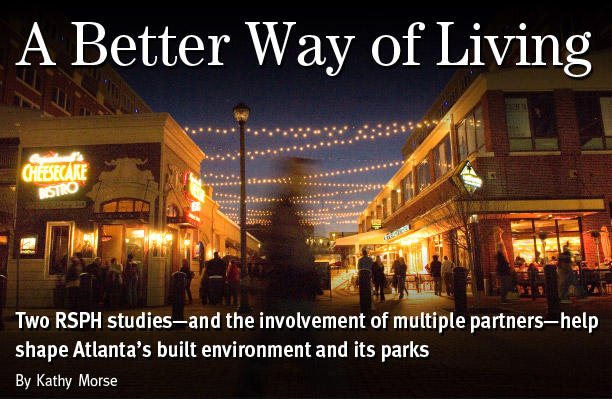 |
| |
|
|
| |
|
|
| |
|
|
 |
If
you could walk to your neighborhood grocery store, and bike paths
led from your home to your office, would you keep your car in the
garage, become less sedentary, and lead a healthier lifestyle? If
nearby parks were cleaner, better maintained, and easier to access,
would you use them more? |
 |
| |
|
|
 |
Two
studies conducted by the Rollins School of Public Health (RSPH)
are adding to our knowledge of what motivates behavior that could
reduce the prevalence of cancer, heart disease, and obesity in our
society. These studies—one completed and one just beginning—also
demonstrate the power of partnerships for the school with Atlanta-area
corporations, private foundations, local governments, and the Emory
community.
For two years, the RSPH carried out
a study of the City of Atlanta parks system. Funded by the Arthur
M. Blank Family Foundation, the study paired RSPH researchers with
the Goizueta Business School whose MBA students interviewed park
users and conducted park inventories. These findings are helping
the city allocate resources of money and manpower to maintain and
improve its parks while it prepares to add another 1,200 acres of
green space through the Atlanta BeltLine project.
Now the RSPH is launching a three-year
study of the health effects of living in Atlantic Station, a new
planned community in midtown Atlanta where you can “live,
work, and play.”
Researchers will collect data before
people move into their new homes and again once they have lived
for a year in a community where opportunities for physical activity
have been engineered back into their daily lives. Funded by the
CDC through the Emory Prevention Research Center (EPRC) at the RSPH,
the study would not be possible without the involvement of Atlantic
Station developers.
The CDC, through its “Healthy
People in Healthy Places” initiative, awarded $420,000 to
the EPRC for the three-year project, “Studying Walkability
and Travel (SWAT): Assessing Residents in the Atlantic Station Neighborhood.”
“The design of this study will
help us learn if there is an effect on the health of residents who
move into a community that is more walkable,” says Andrew
Dannenberg, medical officer with the CDC’s National Center
for Environmental Health.
Emory is one of two CDC-funded Prevention
Research Centers in the United States that received such a grant.
The second is in St. Louis, where residents in the New Town community
will be studied. “The researchers involved in both studies
will talk to each other,” says Dannenberg. “They will
share the same protocols and instruments so the results can be compared.”
“We want to follow the exact
same procedures in Atlanta and St. Louis so we can combine the data
and learn from the results of a larger population,” adds Karen
Glanz, EPRC director. “This experiment will allow us to test
the thinking of a lot of public health researchers about communities
designed for more active living where people use their cars less.
We are looking at physical activity associated with several kinds
of cancer, cardiovascular disease, and obesity—all of which
have a very direct tie to the EPRC’s main mission.” |
 |
| |
|
|
 |
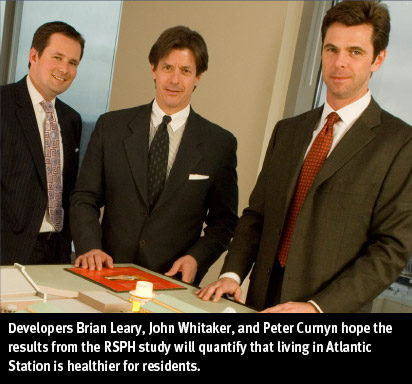 |
 |
| |
|
|
 |
Before
and after
The SWAT study is being launched concurrent
with a separate event highlighting Atlantic Station as a model of
smart growth. “We will learn whether and how a mixed-use environment
with good sidewalks and nearby destinations encourages people to
walk and reduce their use of automobiles,” says Karen Mumford,
principal investigator for the study in the RSPH’s Department
of Environmental and Occupational Health.
According to CDC data, only 25% of
adult Americans are physically active 30 minutes a day, most days
of the week, as recommended by health experts. Nearly one in three
has no leisure-time physical activity. More and more, researchers,
developers, and the public are focusing their attention on the “built
environment” and strategies for engineering physical activity
back into people’s daily routines. Settings that encourage
biking and walking may reduce automobile use, traffic congestion,
and pollution.
Mumford believes the residents of
Atlantic Station will provide important answers. Participants “are
motivated by the thought of helping to contribute to public health
knowledge—and some are intrigued by the gadgets involved,”
she says. “There also is a small financial incentive: a $25
gift card to Atlantic Station stores the first year and a $50 card
at the end.”
Participants, eventually 200 in all,
will perform several tasks a few months before they move to Atlantic
Station and again a year later. They will:
• Fill out a short survey about
their age, health, and habits (everything from dog ownership to
recreational activities and personal barriers to physical activity).
• Wear activity and travel monitoring
devices (an accelerometer and GPS data logger) for five days. Atlanta-based
GeoStats, a study partner, developed the monitoring tools.
• Complete a five-day travel
and activity log to record where they go and how they got there,
what time they arrived and left, and what they did there.
“Atlantic Station is the perfect
laboratory for us,” says Mumford. “We can study whether
changes in the physical and social characteristics of neighborhoods
have an impact on health by encouraging more walking, for example.”
|
 |
| |
|
|
 |
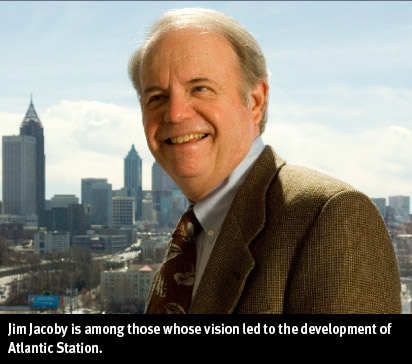 |
 |
| |
|
|
 |
Marketing
results
The developers of Atlantic Station are just
as interested in the data that the study will reveal, which may
quantify the quality-of-life benefits they envisioned in the community’s
design. They are providing access to new residents as study participants
and supporting the study with a grant of their own.
Atlantic Station is the nation’s
largest urban brownfield redevelopment project on the 138-acre site
of a former steel mill that opened in 1901. At the turn of that
century, the property was on the outskirts of the town. With time,
Atlanta became a railway and airline transportation hub intersected
by three interstate highways. Growth spread as far as automobiles
could take commuters to and from work each day.
Atlantic Station LLC (a joint venture
between AIG Global Real Estate and Jacoby Development) bought the
land in 1999 with a shared vision of how to rescue this environmentally
impaired site for redevelopment into a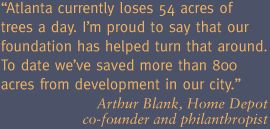 valuable mixed-use property. When completed, Atlantic Station will
provide houses, town homes, condos, and apartments for 10,000 residents
and a workplace for 40,000 people. The community offers retail stores,
restaurants, theaters, and 11 acres of parks and green spaces. Bike
trails, wide sidewalks, “share” cars, and trolleys linked
to MARTA’s bus and rapid transit system provide transportation
options.
valuable mixed-use property. When completed, Atlantic Station will
provide houses, town homes, condos, and apartments for 10,000 residents
and a workplace for 40,000 people. The community offers retail stores,
restaurants, theaters, and 11 acres of parks and green spaces. Bike
trails, wide sidewalks, “share” cars, and trolleys linked
to MARTA’s bus and rapid transit system provide transportation
options.
“Atlantic Station is part of
the Renaissance of the west side of Atlanta with Georgia Tech, Coca-Cola
headquarters, and the World Congress Center,” notes Jim Jacoby,
president and chairman of Jacoby Development.
Realizing
a dream
The vision for turning the steel mill site
into a community where people would “live, work, play”
began as a master’s thesis on city planning by Georgia Tech
student Brian Leary. He now serves as vice president, design and
development, of Atlantic Station, LLC, with a high-rise office overlooking
a dream that became reality. All that was possible once New York-based
AIG insured the environmentally challenged property and became its
developer.
“We looked at great urban neighborhoods
across the world and figured out why they worked,” says Leary.
“Cities like Savannah grew at a walking pace; Atlanta grew
at 55 mph. Now people in Atlanta are tired of the gridlock. We’ve
built a community the way it was defined 100 years ago. People can
get out of their cars and live close to where they work, shop, and
enjoy restaurants and movie theaters and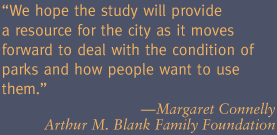 reach it all on foot. They can walk to where they like to walk rather
than drive to where they like to walk. Convenience is important,
but it’s also a healthier way of living—physically,
mentally and emotionally.”
reach it all on foot. They can walk to where they like to walk rather
than drive to where they like to walk. Convenience is important,
but it’s also a healthier way of living—physically,
mentally and emotionally.”
“Atlantic Station is always
evolving and learning ways to make it even more green and healthy,”
says Peter Curnyn, vice president–development for AIG Global
Real Estate. “There is a perception that building green is
exponentially more expensive, but that’s not really the case
if you are creative and careful in terms of your architectural design
and selection of materials. You can even see the stars in Atlantic
Station. The Sierra Club gave us the idea of using streetlamps with
topside shades so the lights shine down and not up.”
Atlantic Station’s developers
naturally were attracted to Mumford’s study. “You can’t
get two more respected organizations than Emory and the CDC,”
says Leary. “If they ask us to work with them, it is almost
a ‘yes’ before you know what it is. We’re providing
$150,000 for whatever the study needs and access to study participants.
We see this as clear value added. There is real market value for
us if we can quantify that living in Atlantic Station is healthier.”
The Novare Group is among three residential
developers that are providing access to their residents for the
Emory researchers. Mike Everly is president of the company, which
will add a 46-floor condo building next to its existing 26-floor
investment.
“We believe those who move into
town are excited about the urban experience and will be receptive
to participating in this type of study,” Everly says. “I’m
interested in learning how many of our buyers are moving into town
to be closer to work compared with those attracted by the great
amenities available in Atlantic Station and midtown.” |
 |
| |
|
|
 |
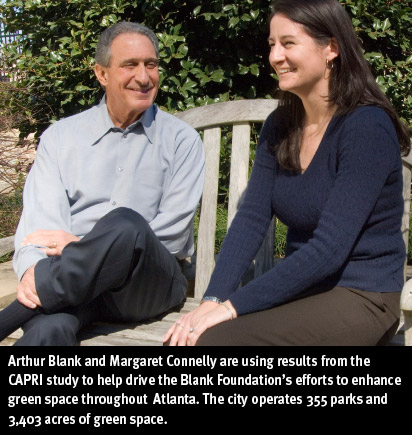 |
 |
| |
|
|
 |
Creating
great parks
The successful collaboration under way at
Atlantic Station was preceded last year by a compelling study on
park use. The City of Atlanta Park Research Initiative (CAPRI) was
an outgrowth of a goal shared by the city and the Arthur M. Blank
Family Foundation to improve green space in the city.
“This was a wonderful combination
of private and public support to do good work,” recalls Mumford.
“The Blank Foundation is an icon in the community. It supports
important initiatives that benefit local communities, such as contributing
to the expansion and improvement of parks and green space in the
metro Atlanta region. It provided a grant for our study. The RSPH
contributed their experience in developing and conducting intercept
surveys of park users and inventories of parks. The MBA students
at Goizueta gained valuable experience in gathering and analyzing
the data and making recommendations. Now the City of Atlanta has
data that can aid in decision-making. This study produced multiple
benefits for students and researchers as well as the City of Atlanta.”
The city operates 355 parks with 3,403
acres of green space, including larger entities such as Piedmont
Park and Freedom Park. But the city didn’t have a current
inventory of parks and park features or information on park users
and accessibility. Soon the city would be acquiring another 1,200
acres of land as part of the BeltLine project in which old railroad
right-of-ways would connect 40 existing parks.
The Blank Foundation, created in 1995,
is committed to helping develop a system of great parks in Atlanta
and spurring greater public-private investment in the city’s
environmental well-being.
“If we can help create this
system of parks, then we can have a real impact on quality of life
for Atlantans, particularly in urban neighborhoods,” says
foundation chairman Arthur Blank. “Great parks can improve
health through increased physical activity, and they provide places
where children and families can safely play and connect with one
another and reduce social isolation. For Atlanta to remain a great
city, we need great parks.”
To that end, the foundation has formed
productive relationships with numerous partners, including the City
of Atlanta and Emory. “The city has been our partner from
the very beginning and on many levels,” says Margaret Connelly,
program director for the Blank Foundation. “Mayor Shirley
Franklin and parks commissioner Dianne Harnell Cohen have been incredible
champions of green spaces and provided real leadership in helping
create a world-class parks system.
“Our foundation feels that the
more information we have about parks and how people use them—why
they go there, how they get there, what they do when they are there—the
better investment we can make. The BeltLine project is a once-in-a-lifetime
opportunity for the city to address issues around parks, transit,
affordable housing, and how communities interact with one another.
As a foundation, we love the idea of a connected system of green
spaces, parks, and trails.” |
 |
| |
|
|
 |
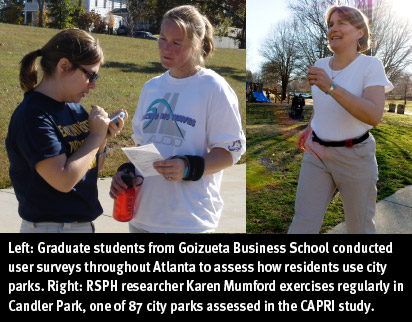 |
 |
| |
|
|
 |
Perfect
symmetry
The foundation started a conversation with
Emory around how to create an inventory of park features and conditions,
to understand how residents view the parks and their policies (such
as hours of operation) and determine how accessible the parks are
and how that relates to their usage.
“We saw a nice symmetry between
Goizueta Business School and the RSPH,” Connelly says. “We
had worked with Karen Mumford at the RSPH on the parks study in
DeKalb County. She helped guide what the instruments look like,
how to create the data in a usable format, and where to house it,
and she gave it the public health perspective. Through Michael Sacks
at Goizueta, we provided real-life experience for the students,
working collectively on one issue.”
The project was assigned to 150 first-year
MBA students as part of their Introductory Leadership course, explains
Sacks, associate professor in the practice of organization and management.
“They learned survey design and analysis, project and team
management, presentation design—and adapting to situations
when things don’t go according to the project plan.”
He adds, “This is what our school should be doing—connecting
what happens in the classroom to real work.”
The students laced up their sneakers
and took their Palm Pilots and inventory sheets to 87 parks where
they listed facilities and conditions such as usability, structural
integrity, and cleanliness. They marked pedestrian and automobile
access on a map. For the second phase, they returned to the parks
to conduct user surveys one day on the weekend. More than 1,000
people filled out a brief questionnaire on their age and residence,
their travel and park use patterns, and their views on policies
such as hours of operation and future park development goals.
In spring 2006, 13 students volunteered
to analyze the data with the help of an advisory committee, using
techniques of statistical analysis, marketing strategy, and decision
modeling. They defined park-user segments (such as “leisure
lovers” and “sports enthusiasts”) for marketing
efforts, identified key parks to target for improvement, as well
as features such as cleaning up litter and graffiti that need attention
across the entire park system, and developed a prototype park funding
decision model.
“What I found most interesting
about the study were the numbers on usage and demographics,”
says Ken Gillett, acting director of parks for the City of Atlanta.
“We learned that Freedom Park is truly a regional park and
draws people from distant zip codes. Many also come from the immediate
community and like the direct and easy access to the park. They
don’t have to walk around the block to get into it.
“This study showed us the value
of keeping parks open and accessible, ways of designing them to
be easy to get into, and how people value that space.”
True to form, the study provided the
Blank Foundation with new information to drive its efforts to enhance
green space while engaging the community. “As a result of
the study, we have more people out there interested in the issue
of parks,” says Connelly. “We hope the study will provide
a resource for the city as it moves forward to deal with the condition
of the parks and how people want to use them. For our foundation,
the more we know, the better we can align our investments with community
needs and interests.”
Kathy
Morse is a freelance writer in Atlanta. |
 |
| |
|
|
| |
|
|
|
|
|
|

